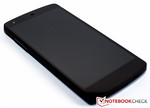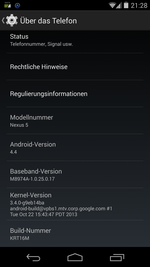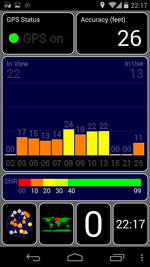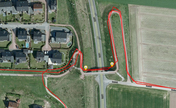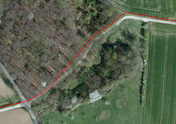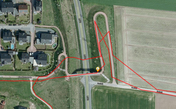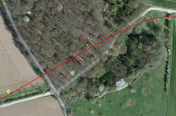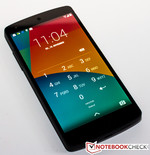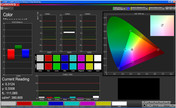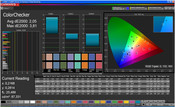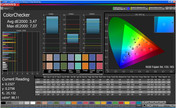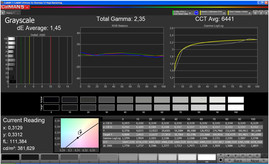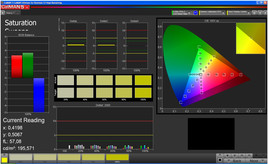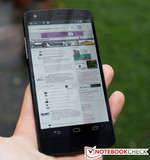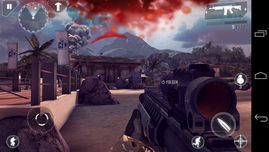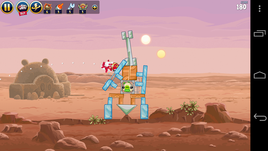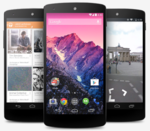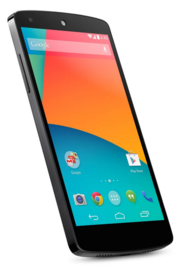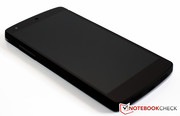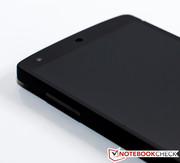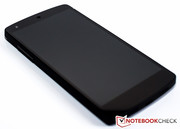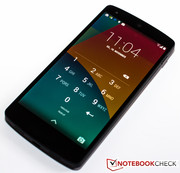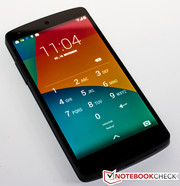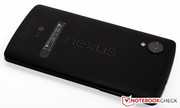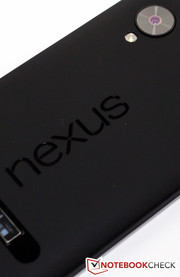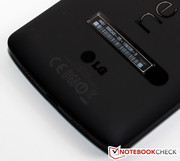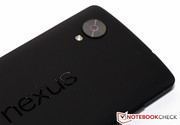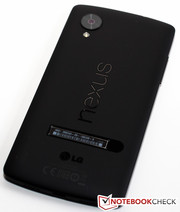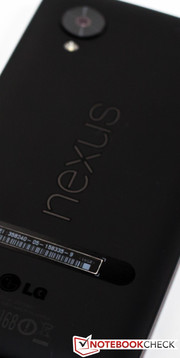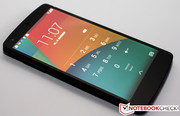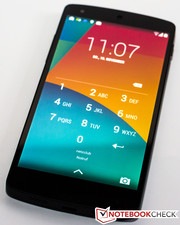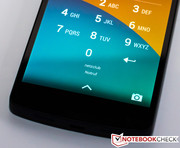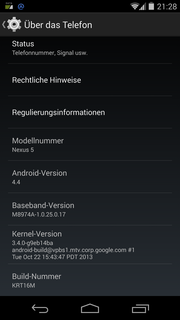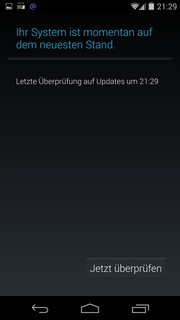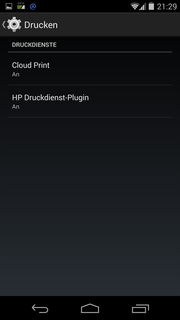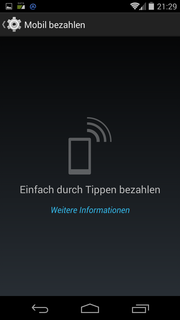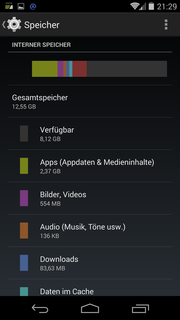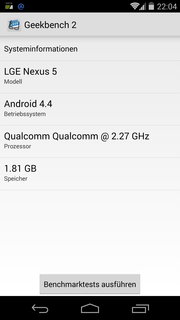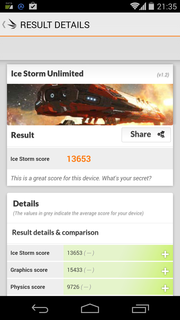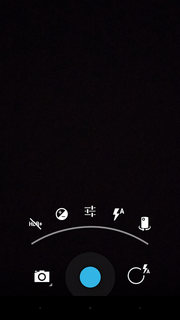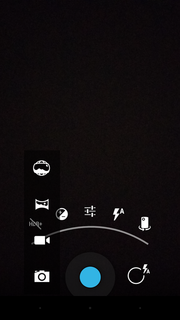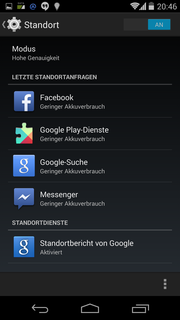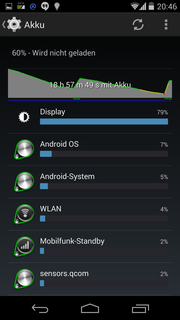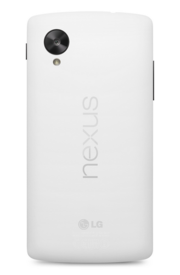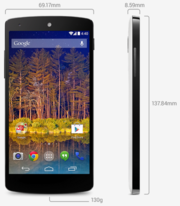Review Google Nexus 5 Smartphone

For the original German review, see here.
Google again awarded the Nexus 5's production contract to LG. Obviously, the Android smiths were very happy with the hardware they delivered in the Nexus 4. The South Korean corporation presented its newest flagship just recently. The LG G2 avails itself of a nearly identical hardware assembly. A Qualcomm Snapdragon 800 with 2.26 GHz per core and 2 GB of RAM works under the Nexus 5's plastic case. The Full HD display measures 4.95 inches and is protected by Corning Gorilla Glass 3. Nothing has changed in terms of camera resolution; however, there is a long-expected novelty in comparison to the Nexus 4 – the built-in LTE module. These days, there is a wide selection of smartphones with Snapdragon 800, but among them only the LG G2 has a similarly large screen. The Galaxy Note 3 measures 5.7 inches; the Sony Xperia Z Ultra even reaches 6.4 inches yet still calls itself a "smartphone." We will assess for you in the following sections whether the Nexus 5 can lift itself above the competitors and prove itself Google's secret weapon. One thing is already clear: the hardware data sheet is an attractive read, and the purchase price even more so -- at 350 Euros (~$475) for the 16 GB Version and 400 Euros (~$550) for 32 GB, the competition has nothing to laugh at.
The Nexus 4 case's edge consists of the same material as the entire underside of the Nexus 5. Google and its manufacturer LG bid farewell to the glass underside and seize upon matte, grippable polycarbonate. The material feels quite high quality and stable. We could not discover any flaws in the workmanship with pointed pressure or twisting.
In contrast to the case of the LG G2, the thought that the machine could slip out of the hand, because its underside is so smooth, no longer intrudes. The slightly curved side edges strengthen the positive impression of the Nexus's look and feel.
In its length, the Nexus 5 is somewhat shorter (137.84 mm) than the LG G2 (138.5 mm) (~5.43 vs. 5.45 inches respectively). We measured the same width (69.17 mm) and thickness (8.59 mm) (~2.64 and 0.34 inches respectively). Still, one must give the G2 points, for having a 0.2-inch-larger display built in.
Google has successfully put its new device on a diet. The Nexus 5 is a proud nine grams (~0.3 ounces) lighter (130 grams; ~4.6 ounces) in comparison to its predecessors.
One searches in vain for the peculiar layout of the keys the LG G2 has. For Google, this was obviously too much innovation at once -- a pity, actually, since the G2's arrangement grew on us after just a short testing time getting used to it. As with several smartphones, the power button can be found on the right upper side, and the volume control lies directly under it. The 3.5-mm audio jack is on the top side and the USB port and stereo speakers are found on the lower side.
The Nexus 5 is currently available in two color variations (black, white) and can be purchased with either 16 or 32 GB. Our test model has 16 GB of storage at its disposal. Unfortunately, this cannot be expanded, and the battery cannot be switched out. Still, the specialists of ifixit.com have awarded the Nexus 5 a good reparability rating.
Software
The hype over the Nexus 5 is no greater than that over the latest Android version.
Our test machine is the first smartphone equipped with Android 4.4 KitKat. The optical adaptations immediately catch the eye; everything just looks a bit fresher. The status bar and navigation bar are now transparent, which has the consequence, that the display appears somewhat larger.
Both bars disappear inside of opened apps, which consequently wins the display more space. This only works as long as the application supports this function. In general, Google has spruced up many of its applications and settings. Some apps receive new logos, and among these there is often a new design as well. For example, the telephone function or the news app, which have been completely replaced by "Hangouts." Similarly remodeled is the Office function, which is preinstalled with the Google app "Quick Office." The efficient integration of printing services is interesting. If the smartphone is connected with "Google Cloud Print" or "HP ePrinter," documents can be printed out from anywhere. We are pleased by the strong integration of "Google Now." This forecasting service for all of life's situations now has its own home screen site and is more omnipresent.
Apart from the numerous new functions, the system performance has been tweaked just as thoroughly. Under the hood, several new features ensure a more smoothly running system and resource-efficient work. This shows itself, for example, in the fact that Android 4.4 can be installed on devices that offer only 512 MB of RAM. Another indication of the untapped potential: the implemented, but deactivated function of the new virtual machine ART (Android Runtime). This compiling method is supposed to replace the renowned Dalvik Runtime in the near future and ensure faster performance.
Communication & GPS
In this segment of the test, the device can make use of its variety of modules. The Nexus 5 offers up a nearly complete portfolio of modules and connections. The high speed WLAN module transmits according to 802.11 a/b/g/n/ac in dual-band mode (2.4 GHz and 5 GHz). As long as the corresponding infrastructure is available, it can reach high transfer rates. Away from WLAN, the test machine makes a connection to mobile Internet, chiefly LTE. As long as no corresponding mobile transmission contract has been completed, the smartphone automatically falls back on UMTS. Here, download rates lie at a maximum of 42.2 Mbit/s. At short ranges, Bluetooth in Version 4.0 can be used. If the distance between smartphone and base station is even smaller, the NFC Module can also be used. Here the Nexus 5 is supposed to earn its keep. Clear through several series of tests and over the complete testing time period, we could not ascertain any broken connections. The sending and receiving performance of the module convinces us.
The aGPS module offers the Nexus 5 the ability to be used as a fully-functional navigation system. Even within closed rooms, it can make a connection with impressive speed. The duration of the satellite fix essentially depends on the quality of the existing Internet connection. In order to see the module's precision more transparently, we compared the GSP receiver with a reference product from the manufacturer Garmin. The recently-tested Apple iPhone 5S performed admirably in this discipline. Unfortunately, this is not the case with Google's premier model. On the "Google Maps" map, our bicycle tour looks more like a zigzagging tracking hike over sticks and stones. On a passage through a thickly-wooded area, the module makes everything easier and just shows the direct line as the crow flies. The end result is not satisfactory, since the Nexus 5 simply removed a striking 500 m from our test journey. With longer bicycle trips or jogging activities, this difference is not to be ignored.
Cameras & Multimedia
Same manufacturer, different camera module. With the LG G2, the main camera depends on a sensor with a maximum resolution of 13 MP. A reduced version is offered in the Nexus 5. At 8 MP, the camera still has a high resolution, but the user must reckon with less detail. The front camera offers only a meager 1.3 MP. As we know from the stock camera in the Android operating system, the software is rather spartan. Current smartphones, such as those from Samsung, have numerous camera functions for every imaginable situation at their disposal.
The LG G2's sensor is certainly capable of capturing more details in the pictures it shoots, but the results from the Nexus 5 are, overall, convincing. There is a high degree of detail sharpness and the pictures present the original colors correctly. The camera has problems with poorly lit conditions, which cause blurring and lead to an unrecognizable portrayal. The HDR function helps here, but users should not expect miracles. In comparison with the camera module of the Nexus 4, Google and LG have upped the ante, with a noticeably better result.
Telephone functions and speech quality
After a week of use, we had spent several hours using the smartphone's telephone function. As long as the net coverage was available in high enough quality, we had nothing to complain about in terms of speech quality. Our counterpart confirmed a clear voice rendering without any background noise. The built-in speakerphone function could still be a bit louder. To the extent the user wants to use the phone in the car, the combination of speakers and microphone will be put to their limits. Unfortunately, Google did not include a headset in the packaging, so users must either avail themselves of option accessories or fall back on the acceptable speakerphone.
Accessories & Warranty
Users who purchase the phone through the Google Play Store can take advantage of the warranty for up to 12 months. If the Nexus 5 is purchased from another seller, the warranty can be used for 24 months after the purchase date. The guarantee lasts for 24 months total -- even for devices bought in the Play Store. In both cases, the warranty can be redeemed because of a battery defect for only 6 months.
Google includes a modular power cord in its delivery package. The user must forgo an in-ear headset or additional extras. Users who would like an Original-Cover can order one in the Play Store for 29.99 Euros (~$40).
Input Devices & Service
The LCD screen reacts with precision and can be used with up to ten fingers at once. Inputs are acted upon with almost no delay, and turning the display by 90° hardly takes any time. Because of the large icon presentation and navigation symbols, a high probability of contact is guaranteed. One disadvantage of large symbols is the remaining room on the display. In comparison to the home screen of the LG G2 , significantly fewer applications can fit in the space. Exactly as in on-edge mode, the preinstalled keyboard takes up less than 50% of the display in landscape mode.
Many manufacturers lead the way. The current flagships' displays are getting bigger and bigger. Offhand, we cannot think of any model whose successor has a smaller display. Google is no exception, and gives the Nexus 5 a panel larger by a hair under 0.3 inches. The screen measures exactly 4.975 inches and has a resolution of 1920x1080 pixels, which is adequate for Full HD. The LCD-IPS panel is shielded by Corning Gorilla Glass 3 and delivers 445 ppi. It has a slightly higher pixel density than the LG G2, since its display is slightly larger.
We examined these characteristics more exactly with the X-Rite i1pro 2. On average, the screen achieves a luminance of 469 cd/m², which presents a marked improvement over the Nexus 4 (275.3 cd/m²) and is likewise about 140 cd/m² brighter than the LG G2. The homogeneity, at 94%, is at a very high level, and it out performs that of the iPhone 5S or the LG G2 by leagues.
At 0.49 cd/m², the black level is suitably low, and it can call up a more-than-satisfactory contrast (957:1). In comparison to predecessor models, the black level has slightly increased (0.24 cd/m²), though this is a subjective observation that does not imply any noticeable degradation.
One source of annoyance in our opinion is the software-based navigation buttons. These block off about 5 mm of the usable display. The entire five inches are only available under certain conditions, when the navigation bar and the status bar phase out. This is one problem that the LG G2is also fighting, but which has been totally overcome by the Samsung Galaxy Series. Navigation bars are located outside the display and are supported by the physical home button.
| |||||||||||||||||||||||||
Brightness Distribution: 94 %
Center on Battery: 469 cd/m²
Contrast: 957:1 (Black: 0.49 cd/m²)
ΔE ColorChecker Calman: 2.05 | ∀{0.5-29.43 Ø4.78}
ΔE Greyscale Calman: 1.45 | ∀{0.09-98 Ø5}
Gamma: 2
CCT: 6441 K
The color presentation of the Nexus 5 surprises us in a positive way. Between the "should be" and "is" of color presentation, we can recognize only a minimal difference with red and blue. The other colors are shown very faithfully. As a result, there are only minimal DeltaE-2000 deviations. The average DeltaE-2000 rating is 2.05 (with a maximum of 3.81). Even the brand-new iPhone 5S must take its lumps, with an average of 2.67, to say nothing of the modest rating of the LG G2. In AdobeRGB mode, DeltaE-2000 rises to an average of 3.46, which is still a better position than that of the iPhone 5S (4.06).
The grayscale presentation is also convincing, because it is homogenous and congruent with the ideal curve. In total, this display delivers a superb result. Even the iPhone 5S's built-in panel gets the short end of the stick and must admit defeat.
Thanks to a high average brightness and contrast, almost in the four-digit realm, the contents of the display are very easily readable. The glossy display must still reckon with reflections under strong sunlight, though. Here a matte display protection film would come in handy. This would reduce the brilliance of the display. Still, a matte film is not a silver bullet; with the decreased reflections comes a somewhat poorer display image.
How could it be otherwise? The IPS panel delivers a very satisfactory result. At steep viewing angles, the color fidelity is at a high level and confirms our perception of a good IPS panel. Honestly, we expected nothing different. Thankfully, the search for a flagship without correspondingly good viewing angle stability is currently a vain one.
The SoC in the Nexus 5 is an old friend, and these days it is used in many top models. With the Snapdragon 800, Qualcomm has put an extremely high-quality piece of hardware into play. This goes by the name MSM8974 and performs its tasks according to the instruction set architecture ARMv7. This test device calls up a clock speed of 2.26 GHz. The four Krait cores are supported by the Adreno 330 (450 MHz) and are well suited to play QFHD films (2160p) back. Even though the LTE-capable chipset "only" does its work within 32-bit technology, it is still on a level with the iPhone 5S's processor in terms of speed - especially since there are no 64-bit-compatible apps at the moment. This SoC is likewise used in the LG G2, the Sony Xperia Z Ultra, and in the recently-tested Samsung Galaxy Note 3. The last so-called top model of the Galaxy Note series even has a USB 3.0 port built in. Unfortunately, the Nexus 5 must forgo this feature.
Despite similar hardware in the Android-based high-end devices, the difference in benchmark results is not insignificant, even if a subjective difference is hardly observable. The Nexus 5 encounters its first hurdle in the form of the synthetic run time test. The first thing to catch our eye is that our test machine has almost no chance against the results of the iPhone 5S, since with up to 445% it is simply inferior. In general, we can say that all four Android top models switch off among the top scorers. In the Google realm, there is no one obvious winner to identify, though it is clear, that performance, in comparison to predecessor models, has markedly increased.
| GFXBench (DX / GLBenchmark) 2.7 | |
| T-Rex Onscreen (sort by value) | |
| Google Nexus 5 | |
| LG G2 | |
| Apple iPhone 5S | |
| Samsung Galaxy Note 3 SM-N9005 | |
| Sony Xperia Z Ultra | |
| Google Nexus 4 | |
| Samsung Galaxy S4 GT-I9505 | |
| 1920x1080 T-Rex Offscreen (sort by value) | |
| Google Nexus 5 | |
| LG G2 | |
| Apple iPhone 5S | |
| Samsung Galaxy Note 3 SM-N9005 | |
| Sony Xperia Z Ultra | |
| Google Nexus 4 | |
| Samsung Galaxy S4 GT-I9505 | |
| Epic Citadel - Ultra High Quality (sort by value) | |
| Google Nexus 5 | |
| LG G2 | |
| Samsung Galaxy Note 3 SM-N9005 | |
| Sony Xperia Z Ultra | |
| Google Nexus 4 | |
| Samsung Galaxy S4 GT-I9505 | |
| PassMark PerformanceTest Mobile V1 - System (sort by value) | |
| Google Nexus 5 | |
| LG G2 | |
| Apple iPhone 5S | |
| Samsung Galaxy Note 3 SM-N9005 | |
| Sony Xperia Z Ultra | |
| Google Nexus 4 | |
| Samsung Galaxy S4 GT-I9505 | |
In relation to the iPhone 5S, the same picture appears, as was the case with the previous benchmarks. The Apple flagship forges ahead, uncatchable, in first place. Increasingly often, the Nexus 5 can distance itself from its Android competitors. The integration of Google Chrome definitely has a bit to do with this. In most tests, Lumia 1020 cannot hold its own against the tested top models.
| Octane V1 - Total Score (sort by value) | |
| Google Nexus 5 | |
| LG G2 | |
| Apple iPhone 5S | |
| Samsung Galaxy Note 3 SM-N9005 | |
| Sony Xperia Z Ultra | |
| Google Nexus 4 | |
| Nokia Lumia 1020 | |
| Samsung Galaxy S4 GT-I9505 | |
| HTC One | |
| Peacekeeper - --- (sort by value) | |
| Google Nexus 5 | |
| LG G2 | |
| Apple iPhone 5S | |
| Samsung Galaxy Note 3 SM-N9005 | |
| Sony Xperia Z Ultra | |
| Google Nexus 4 | |
| Nokia Lumia 1020 | |
| Samsung Galaxy S4 GT-I9505 | |
| HTC One | |
| Mozilla Kraken 1.0 - Total (sort by value) | |
| Google Nexus 5 | |
| LG G2 | |
| Apple iPhone 5S | |
| Samsung Galaxy Note 3 SM-N9005 | |
| Sony Xperia Z Ultra | |
| Google Nexus 4 | |
| Nokia Lumia 1020 | |
| Samsung Galaxy S4 GT-I9505 | |
| HTC One | |
| Browsermark - --- (sort by value) | |
| Google Nexus 5 | |
| LG G2 | |
| Apple iPhone 5S | |
| Samsung Galaxy Note 3 SM-N9005 | |
| Sony Xperia Z Ultra | |
| Google Nexus 4 | |
| Nokia Lumia 1020 | |
| Samsung Galaxy S4 GT-I9505 | |
| HTC One | |
| WebXPRT 2013 - Overall (sort by value) | |
| Google Nexus 5 | |
| LG G2 | |
| Apple iPhone 5S | |
| Apple iPhone 5S | |
| Samsung Galaxy Note 3 SM-N9005 | |
| Google Nexus 4 | |
| Nokia Lumia 1020 | |
| Samsung Galaxy S4 GT-I9505 | |
| Sunspider - 1.0 Total Score (sort by value) | |
| Google Nexus 5 | |
| Google Nexus 5 | |
| LG G2 | |
| Apple iPhone 5S | |
| Samsung Galaxy Note 3 SM-N9005 | |
| Sony Xperia Z Ultra | |
| Google Nexus 4 | |
| Nokia Lumia 1020 | |
| Samsung Galaxy S4 GT-I9505 | |
* ... smaller is better
With regard to the speed of the flash drive, we must definitely apply a few deductions. The Galaxy Note 3 as well as the LG G2 reach sequential read rates (256 KB) of over 100 MB/s - our test product can only dream of this. It is surprising that the Google Nexus 4 shows more performance than its successor in occasional read and write tasks. In the area of the flash drive, Google has obviously not built in the optimal current hardware.
Videos & Games
2.26 GHz, 2 GB of RAM and a suitable SoC for playback of QFHD material: With these facts in hand, all questions of video and game fitness should be cleared up. Still, we delved a little more deeply in this area of the test. With various trailers and at different qualities, we tested whether the SoC delivers what it promises. Our ultra high definition trailer was played back at up to 20.8 MBit/s. Throughout the complete sequences, we could not ascertain any stutters or lost images. Everything played back to our satisfaction with the preinstalled Google Player. Therefore, it is not surprising that every imaginable game from the Play Store can be used without a problem.
Temperature
Despite high performance, we observe low temperatures under load. Here we measure (on average) 33.5 °C (92.3 °F) on the upper side and only 32.4 °C (90.32 °F) on the underside. Even at maximum ratings, everything remains reasonable. LG G2 achieves somewhat higher values (3 °C – 4 °C; 37.4 to 39.2 °F) and levels off in the area of the iPhone 5S. Average temperatures of 28 °C (82.4 °F) are obtained on the front side, if the smartphone is not performing any processor-intensive functions. Here too, the Nexus 5 can hold its own against the iPhone flagship and the LG G2, even if the difference is only meager.
The power cord possesses a fairly cool case. On the upper surface, we measure a maximum of 34.5 °C (94.1 °F) under full load.
(+) The maximum temperature on the upper side is 36.2 °C / 97 F, compared to the average of 35.2 °C / 95 F, ranging from 21.9 to 247 °C for the class Smartphone.
(+) The bottom heats up to a maximum of 36.5 °C / 98 F, compared to the average of 34 °C / 93 F
(+) In idle usage, the average temperature for the upper side is 28 °C / 82 F, compared to the device average of 32.9 °C / 91 F.
Speakers
The USB interface and the speakers are located to the right and left on the device's underside. The layout is identical to that of the stepsister model, the LG G2. This positioning of the speakers has the advantage that they are not covered when the smartphone lies on a flat surface.
At about 70% of the volume, the highs are suddenly, markedly raised, and an unpleasant sound pattern appears, caused by overmodulation. This difference is also strengthened, in that the sound has a dampened effect at low levels. In this area of testing, the question poses itself, whether the affordable purchase price is one cause of the undistinguished speakers. Unfortunately, it is somewhat difficult to plug in an in-ear headset, since Google did not include one in the delivery package of the Nexus 5. Still, it quickly manages a Bluetooth connection, which helps clear up the mess as long as a compatible device is available.
Power Consumption
In general, it is often assumed, that the same SoCs need the same power consumption. Despite this, additional factors play a deciding role. With our test model, we measure consumption of 4.3 to 8.4 W under load. With the substantially larger Galaxy Note 3, a maximum of 6.5 W are needed, and even the larger LG G2 is satisfied with a maximum of 4.8 W. The built-in display and its technology play a not inconsiderable role here. When the Nexus 5 idles, it needs between 0.3 and 1 W.
At 1.4 W, the Galaxy Note 3 is somewhat more power-hungry, and the LG G2 also draws more power from its battery (1.4 W). As long as the device is completely shut down, we measure no power. In standby mode, the Voltcraft VC 940 demonstrates a need for 0.1 W. The Nexus 5 is therefore only thrifty in its power consumption when it does not need to run many performance-intensive tasks.
| Off / Standby | |
| Idle | |
| Load |
|
Key:
min: | |
Battery Life
Battery life presents one of the most hotly discussed themes of the moment. Hardly a single current smartphone in the 5-inch display class manages to last a full day under moderate use. A large machine like the Galaxy Note 3 has an advantage: its case offers a lot of room for a large battery. For this reason, the tablet offers good performance in terms of battery life. In recent weeks, the LG G2 especially surprised us, because it is equipped with a 3,000-mAh dynamo and delivers fabulous run times. The Nexus's 2,300 mAh certainly suggests that its stepsister model's respectable results are hard to top. To make matters worse, the Nexus 5 has higher power consumption under load. Still, in comparison to the Nexus 4, the battery has received an upgrade.
We simulate the full-load scenario with the "Stability Test." For this, display brightness is at maximum and all transmission modules are activated. After 3 hours, 8 minutes, the level sensor alerted us that a charging session was needed. The maximum machine run time, with deactivated display, has a duration of 18 hours, 27 minutes. We achieve a mix of both example cases with the help of an Internet script that opens a new web site every 30 seconds. For this, the display is dimmed to 150 cd/m². The smartphone holds on for a solid 12 hours, 14 minutes.
In comparison with the iPhone 5S, a better run time is possible in WLAN mode and under load. However, against the LG G2, the Nexus 5 only has a shadow of a chance under full load.
Just as with the Nexus 4, Google is making life difficult for its competitors. The 16-GB version of this smartphone can be had for just 350 Euros (~$475). For a doubled capacity of 32 GB, a price increase of 50 Euros (~$75) is in order. Both storage variants are available in black and white. Sony, Samsung and LG have put forward similar hardware combinations. The built-in Qualcomm Snapdragon 800 is extremely high-performance and allows for very smooth functioning. In our test-product, the quad-Core clocked a speed of 2.26 GHz and offered over 2 GB of RAM. Even though the iPhone 5S and the LG G2 often achieve better benchmark results, the difference is not ascertainable in practice. On top: the Adreno 330-GPU is well suited to play videos in QFHD resolution and present them on its 5-inch display with unbelievably high brilliance. Here we gave our test machine extremely good ratings, and the color presentation and color fidelity are absolutely top-of-the-line in the smartphone segment. In addition, at 451.7 cd/m², the display is quite bright and homogeneously illuminated (94%).
The LTE-capable smartphone is equipped with all the current communications modules, and in this area, there is hardly anything left to wish for. We are especially enamored with the workmanship of the case. With the LG G2, the underside offers a minor point of frustration, since this shiny polycarbonate underside is slippery and does not seem particularly high quality, as is the case with the Nexus 5. In terms of battery life, the LG G2 plays in another league. At 2,300 mAh, the Nexus 5 does not really have a chance against LG's flagship. After endless days of tests and work with the smartphone, it could not completely convince us. The purchase price of 350 to 400 Euros (~$475-550) is quite fair, but we still see more potential in the LG G2 (store price: 449 Euros, ~$600, 16 GB), even though the G2 scrapes by with something of a shadowy existence.
Boot Loop Problem
Update 2016-09-22 - Our old Nexus 5 that was used in house suddenly showed the "boot loop" problem where the device would boot up for a few seconds (Google logo shown, vibrating) and then restart. This is a known hardware problem of the on switch that gets stuck. Sometimes it helps to wiggle the button free or tap on the back near the on button. In our case, only removing the power button helped. So now we can only turn the Nexus 5 on with a small screw driver. But at least it works again.





